Article series by Dave Nghiem
So this was it. This was the make it or break it cruise. It was my very first solo sail camping trip in my life. It wasn't my first water-based camping trip but given the sheer differences in equipment, and overwhelming lack of experience I had with sailing, it might as well have been my very first camping trip on the water.
After so much work on the boat the year before (a 20’ Blockley Privateer), I still had a fair amount of work left to get S/V Ghe Ho Dep shipshape. Ghe Ho Dep is Vietnamese for “The Boat of the Tiger.” My Mom gave it that name.
I spent the previous weekend painting the inside. The next weekend was spent on final preparations for the trip. During those two weeks, after work, I was either on the computer making equipment purchases, modifying the ancient mast light (with a lithium ion battery and modern LED light bulbs and mounts), cutting and varnishing wood for the rear hatch mounts (since the hatch was too low to lay on the gaskets), varnishing the head/chart table, and going through equipment lists.
At work it was stressful. It was one of the most consistently busy seasons in the bike shop I’d ever seen. I was burning out fast and couldn't wait to get the hell out of there. August 5th arrived and I left work a little early to get home and finalize my packing.
My friend Dean, an experienced sailor who’d offered to help, came over to pick me up and we loaded his Nissan Xterra, before driving out to the boat. Before we left the D.C. area we stopped at the U-Haul near New Carrollton to fill up one of the propane tanks, and made several stops for tools and stove and lantern fuel.
Afterwards we grabbed dinner at a local Japanese restaurant in Easton, where I ate a fried rice dish and we washed it down with some beer. I discussed my plan with him while looking at the chart page for the Saint Michaels area in my chart book, The Maryland and Delaware Cruising Guide.
"So I want to start in Dogwood Harbor, and sail down to Taylor's Island, where Taylor's Family campground is. There's a marina in there, water, laundry and showers. I know the owner. Do you think that's doable?"
"That looks totally doable. I think you have a good plan." Dean replied.
"You'll have a lot of down time—you brought a musical instrument and something to read?"
"Yeah, but honestly, this is one of my adventure vacations. I'm still working, just it's a different kind of work, so I don't know how much down time I'd have. It's not like a go-to-the-beach with a Martini kind of vacation."
"That's true with how you do things."
He knew me all too well. I live by the saying, "Adventure is 90% boredom, and 10% sheer terror."
We got to the boat late that night and went to sleep. The plan was for me to finish the final repairs the next morning, and then set up in Dogwood Harbor and drop the boat in the water.
I checked the forecast—it was going to be a hot week. Early the next morning I installed the new hatch gasket seals, the varnished wooden blocks for the rear hatch, and loaded and sorted my gear into various compartments.
I noticed the winds in the morning were pretty decent, and the Windy App said there would be around a 14-15 knots coming out of the southeast. This meant headwinds for the entire day.
At Dogwood harbor, we finished stepping the mast and attaching the stays around 3:15 PM, and bent on the sails. We finally put her in the water at 3:30 PM. As we motored out of the harbor we felt the strength of the wind. It was strong. In fact, I noticed there were whitecaps and the overcast sky had a stormy look to it. Soon we had trouble making it across the bay under sail alone.
Dean had me do a bunch of sailing drills before we turned around and sailed up Cummings Creek into Dun Cove for the night. We worked on coming about, heaving-to, and maneuvering. Dean had a blast surfing the boat with the waves, while I was struggling to control my seasickness as I attached the running lights to the front hatch as we bounced over the swells.
The ride was rough and I found myself questioning if my original plan was wise. I even began to think about just heading back to our friend's house, and heading back home for a stay-cation. Then I realized I would be giving up on my adventure. Shaking my head at the thought, I said to myself, Stay the course! I came out here to do this!
While I’d set my mind to stay on track, I puked on the way there. I tried to ignore the fact I got seasick. We arrived in a secluded inlet, with wind protection on three sides. I set the anchor, anod pulled out the tarp to set the boom tent since it was starting to rain. Then I went to lie down in the cockpit on some cushions while Dean pulled out the vegetarian dinner he’d made and packed for us in his cooler. It was pasta salad. I checked the cabin to go about organizing it, and saw the galley dumped on the floor. The galley had come off it's perch in the rocking and rolling.
The cabin was crowded with our things, and the sight irritated me. I had to come up with a better organizational method before we could sleep aboard.
"Man, I just don't want this sail camping trip to be a suffer fest. It's supposed to be my vacation." I said.
"I was just thinking that there are some nice museums to visit in D.C." Dean said.
"Yeah, maybe my initial ambition to get to Taylor's Island is a bit much. What are some other options to that?"
Dean pulled out the chart book and we took a look in the glow of the LED lantern lights.
"I can drop you off here at Easton, and you'd work your way back up to Dogwood Harbor. This whole section is a fantastic place to explore." Dean said as he pointed at the route in my chart book.
I stared at the chart. Despite the small sizes on the chart, the mouth of Cummings Creek looked massive, and the Choptank River, which I was sailing, looked like an ocean. You couldn't even see the main bay of the Chesapeake. Given my skill level, shortening the plan to sail from Easton back to my home port made a lot of sense, especially given my current skill level. I'd only sailed this boat under his supervision three times, and motored it twice before.
I didn't eat much, though we did finish off the peaches I bought, and threw the worst overboard. I bought the peaches the night before, but the bruising and hot temperatures was rapidly over ripening the delicate fruit, and they were attracting flies. The next morning I made us some Vietnamese coffee, and we decided the smart thing to do would be to go back to Dogwood Harbor, pack it up, and drop me off instead at Easton, about an hour's drive away.
I sailed us off the anchor as the winds were now favorable, and we motored back into Dogwood Harbor. We took down the rigging, put the sails and spars in the cabin, strapped everything down, and then drove into Easton. Along the way I filled up Dean's gas tank and we checked the trailer’s tire pressures.
The Sail Camping Trip Begins with Thunderstorms
We drove to the Easton boat ramp at Easton Point. It was well past 5 PM, so everything was closed. We unloaded the boat and started rigging. It was around 6:30 when I mentioned to Dean we should take a break to eat. But he checked the weather and said I needed to leave immediately, as several thunderstorm cells were headed our way.
I looked up and saw the thunderheads were about five miles away. Into the cockpit I went. I turned on the engine as Dean pushed me off and motored out to Dixon Creek, and into the first somewhat protected anchorage I saw. I dropped anchor.
Ten minutes later the wind started to howl and the rain pelted me like bullets. I got a text from Dean advising me to batten down and to set the boom tent. As soon as the tent was up the rain came down in sheets. I sat in the cabin atop the cooler, with one foot in the cabin and the other in the cockpit, watching out the stern as the wind and rain hammered the boat. The wind was changing directions, going back and forth between one point and another for an hour—and so so did the boat.
Luckily I chose an inlet that was shielded on all four sides. If it had been a larger body of water I would’ve been hammered by waves and froth. What a way to start my sail camping trip.
Dean texted me that the power was knocked out in the neighborhood where I kept my boat, and that he was going to hole-up there until it blew over for the night. He mentioned that the rain storm was refreshing.
Refreshing? Immediately a pool of water from the tarp splashed me in the face, giving me an idea.
I stripped down, got up on the stern hatch which was exposed, and let the rain wash the sweat and grime off of me before soaping up for a second round of rinsing. It was crisp, but in the August heat it felt wonderful. My batteries felt recharged. I got back under the tent, dried off, and waited out the storm. The storm went for an hour, stopped for about 30 minutes, and then unleashed itself again for another hour, and stopped again before one final blow out around midnight. It was raining so hard there was water coming through the forward hatch as well as the vent. The high winds continued though the night as I fell asleep.
I woke up the next morning to an overcast sky. I ate some of the leftover pasta dish for breakfast before doing my morning routine.
Afterwards I went through the boat preparation checklist in my head of how to get it ready to sail off the anchor. The wind was favorable. As I needed to go east and south, and with the southwesterly winds, that gave me a beam reach. I also needed to take down the working jib and setup the yankee jib, as the day’s forecast called for winds to 10 knots.
I went up forward, took down the jib, and strung up the yankee. I attached the carabiner we bought at the hardware store to the jib and to the furler.
My routine was to make sure the forward hatch was secure, stow all items and make sure the cabin was clean and somewhat organized.
Next was preparing for sailing. I lowered the swing keel, then I checked the gaff rig’s lines, aka the throat and peak halyards, and made sure they ran to the cockpit. Next I stowed the fenders. Then I checked that the jib sheets were free and that halyards were cleated properly. Messy tangles of rope can get dangerous real fast.
I turned on the engine, put it in neutral, and let it run. I went to the bow to retrieve the anchor rode, and began pulling it in, flaking it in a figure eight pattern as I went. Once I felt that I was close to the anchor breaking free, I waited and watched to see if the weather pointed me in a direction that was advantageous to sail off the anchor.
I felt the wind pick up a bit and watched as the bow soon pointed out of the inlet. At that moment, I raised the anchor completely, shook off any clay, flaked the line, and then I stowed the anchor on top, quickly, before making my way back to the cockpit.
Once I got back to the cockpit, I let out the storm jib, and the boat began to move. Then came the yankee jib, and the boat began to sail. I took the tiller, and while the motor was in neutral, I sailed out of the inlet, and into the Tred Avon River.
My destination for the day, which I reviewed the night before, was Pirate's Cove, up in Trippe Creek, a distance of about 5 nautical miles. I sailed for about a nautical mile before deciding to unfurl the mainsail. Once I did that, the boat started to heel, and I got myself accustomed to it without Dean's presence and guidance.
I was enjoying myself, sailing and navigating the river. Thankfully the Chesapeake Bay area is very well marked, so finding the navigation posts and buoys wasn’t a problem. I sailed down to the junction of the Tred Avon river and Trippe Creek and began to make my turn to port for the river entrance. It was here that I ran into trouble.
Stay tuned for Part II tomorrow.
For more info on the boat, see below.—Eds
Whenever you have a complete newbie sailor sail a craft with no previous sailing experience, you have to take into account where that inexperience skews the reference point. Which means that I have no reference point due to the lack of sailing experience with the most common rig out there, the Bermuda/Marconi Rig.
The Blockley Privateer is a pirate poat. It even comes with a bowsprit! It’s a gaff-rigged, “character boat,” and its LWL is about 16 feet. Max length is just under 20 feet. The max speed we were able to reach in 9-10 knot winds so far is between 5-6 knots. In terms of rigging, there’s no need for winches and winch handles, and because it is a gaff rig, the stresses and strains on the mast, boom, and spreaders are far less than those on a Bermudan rig. This has some pluses and minuses. It's a modern take on the gaff rig design and according to the 1970s marketing brochure, with “modern terylene sails and hollow spars” there is little difference between this rig and the Bermudan, save for some extra complexity that comes with the gaff rig setup.
The minuses? It's “slightly” worse upwind than the Bermuda rig. Conventional wisdom says gaff rigs don’t sail quite as high as a Bermudan. it will physically point a little higher than it will sail to best performance, so don’t point too high or you’re probably losing efficiency. And that’s a difference of only a very few degrees. It helps that this boat is a great motorsailer as well.
Since I've never sailed the Bermuda-rigged equivalent, I can't vouch for the comparison. I can say though that solo sailing the boat was a lot easier than I expected. I had no trouble trimming sails, setting up the rigging, or figuring out my lines during intense periods when there was pressure to perform.
The fact I decided to solo sail for so long, after only three outings with a much more experienced sailor helping out, is either a testament to my ability to perform in a trial by fire, or to the boat’s ease of use low learning curve.
She performs great in light air. The gaff rig includes a topsail and there are three jibs. The modularity of the sails made it easy to adapt to changing conditions. The designers call for extra ballast since the boat is supposed to sail optimally with two adults and two teenagers worth of weight. I had two 5-gallon water containers on board for that, but I'm going to add a battery later as dual-function ballast since I do drink a lot of water.
I haven't had the opportunity to sail in real difficult conditions yet, but according to long-time sailors of the gaff-rigged version of the Privateer, the rig performs well, and far better in rough conditions than the Bermudan. And according to them, in force 5-6 on a broad reach, twice-reefed, she’ll clip at hull speed and in some cases exceed it.
The strangest aspect of the boat is the swing keel, which is set more forward than usual. It's strange because when on most boats the swing keels are located near the mast. This one is forward of the mast. This enables the boat to sail well-balanced with headsails only. The bowsprit seems to have something to do with that. According to the designers, you're supposed to ignore everything you know about centerboards, and approach the swing keel as a trim tab to balance with the aft skeg.
I haven't quite figured out how to set the swing keel properly, and from what I've learned from longtime owners on Internet forums, even after decades of experience with other boats, most still haven't quite mastered the Privateer’s swing keel. But once you figure it out the performance is supposed to be sweet.
The swing keel also makes the boat beachable. The boat is a gunkholer and beach cruiser’s delight. It was designed for the rough seas of British waters, but does well in more protected waters like I was sailing in.
Theoretically there’s room for four—two adults, and two teens. My sailing buddy, who’s 6-foot something, had no trouble getting into the starboard bunk, but in a pinch, with some padding and a boom tent, the cockpit works for sleeping during pleasant weather. There’s a head and a galley, as well as lockers forward and on both sides. The aft locker has plenty of room, and currently houses the propane tank. Some owners referred to the boat a “dinghy with a lid.” Yeah, but once I figured out the basics, it’s a very comfortable dinghy with a lid.
Combining the sails and motor worked very nicely—which was great when it came to going upwind. I have a Tohatsu Sailrite propane outboard motor mounted in the engine well and it was fantastic for motorsailing.
This is a rare, British-made boat with lots of personality. If you happen to come across one and the price is right (which it usually is because most sailors haven’t even heard of the Blockley Privateer,) you can be sure she has enough capability for a lot of your coastal cruising needs. Just make sure you have your Jolly Roger, flintlock, powder, and cutlass aboard. •SCA•

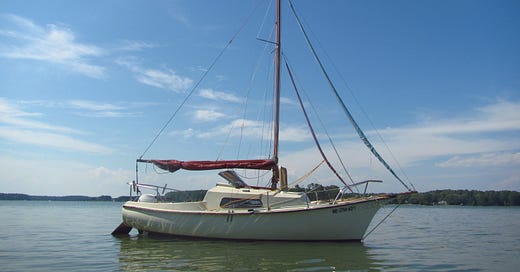

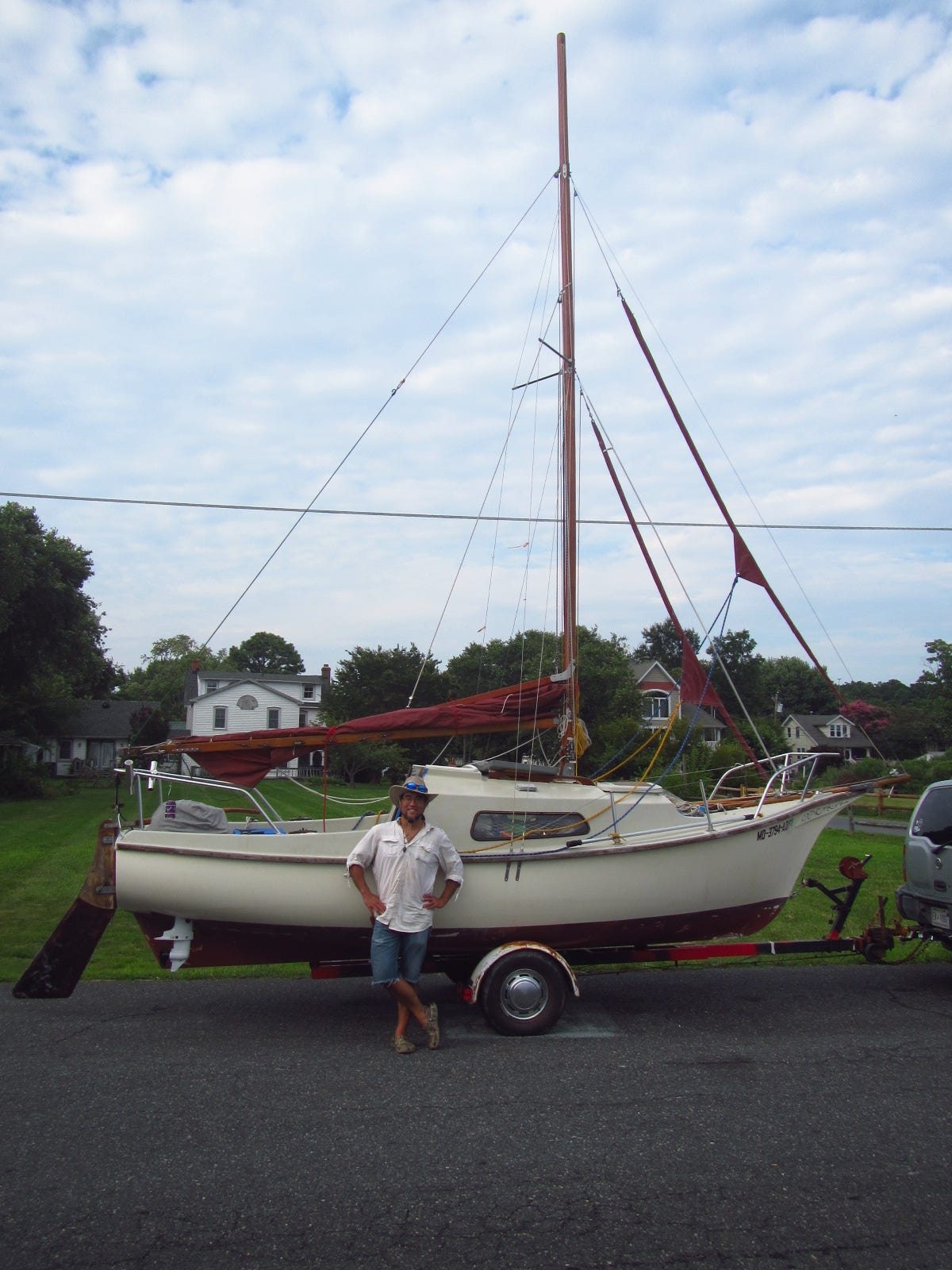
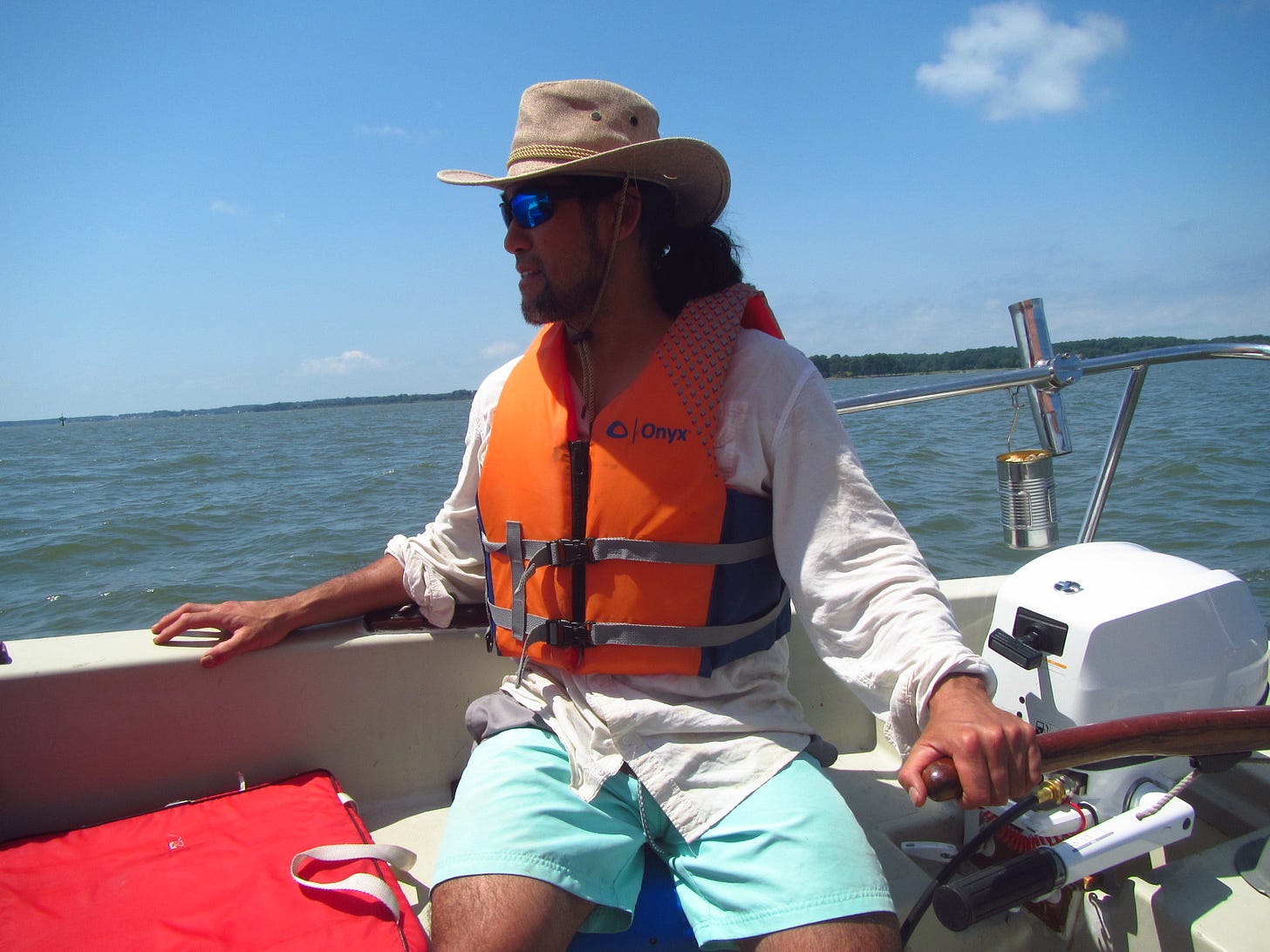
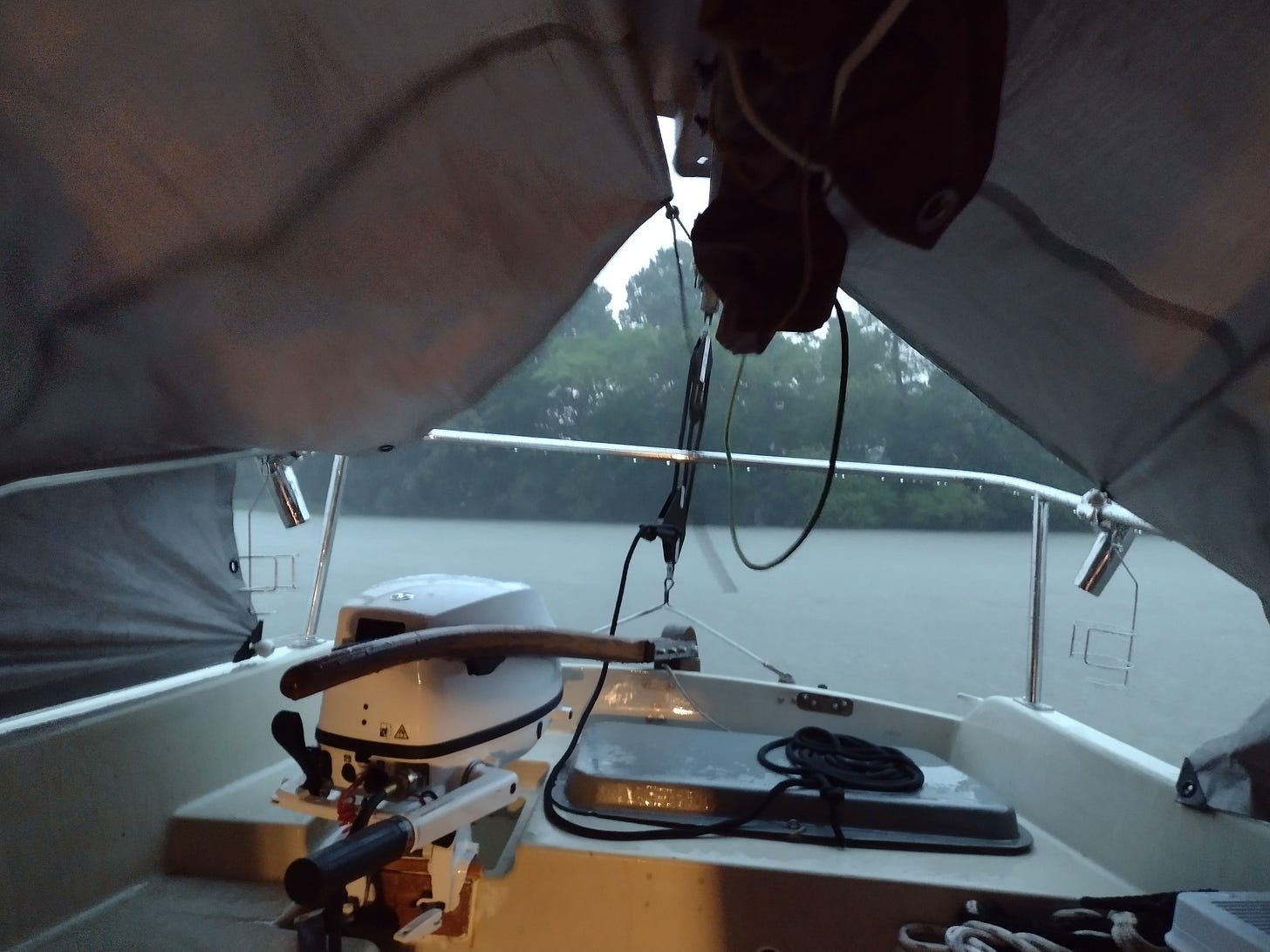
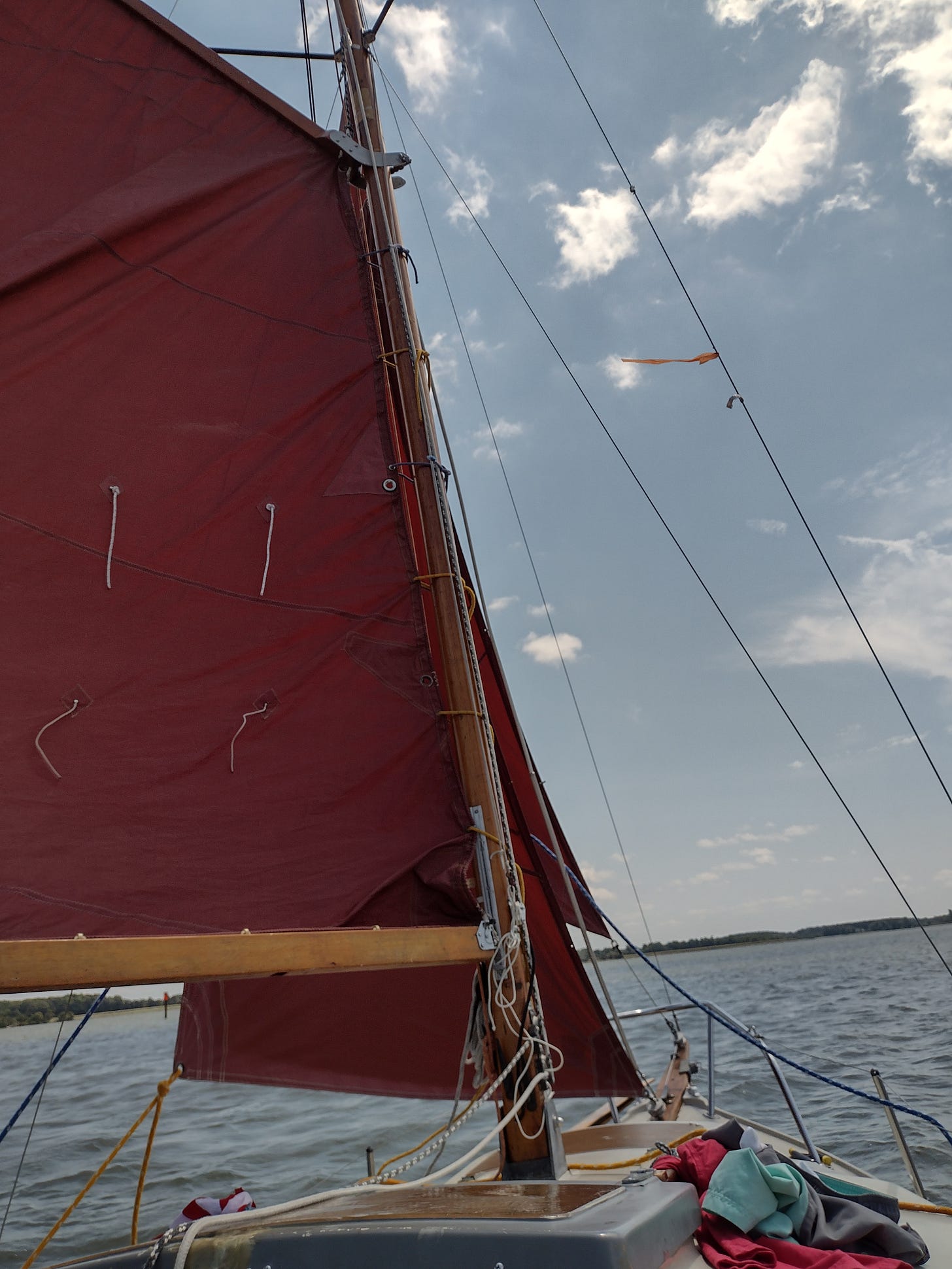
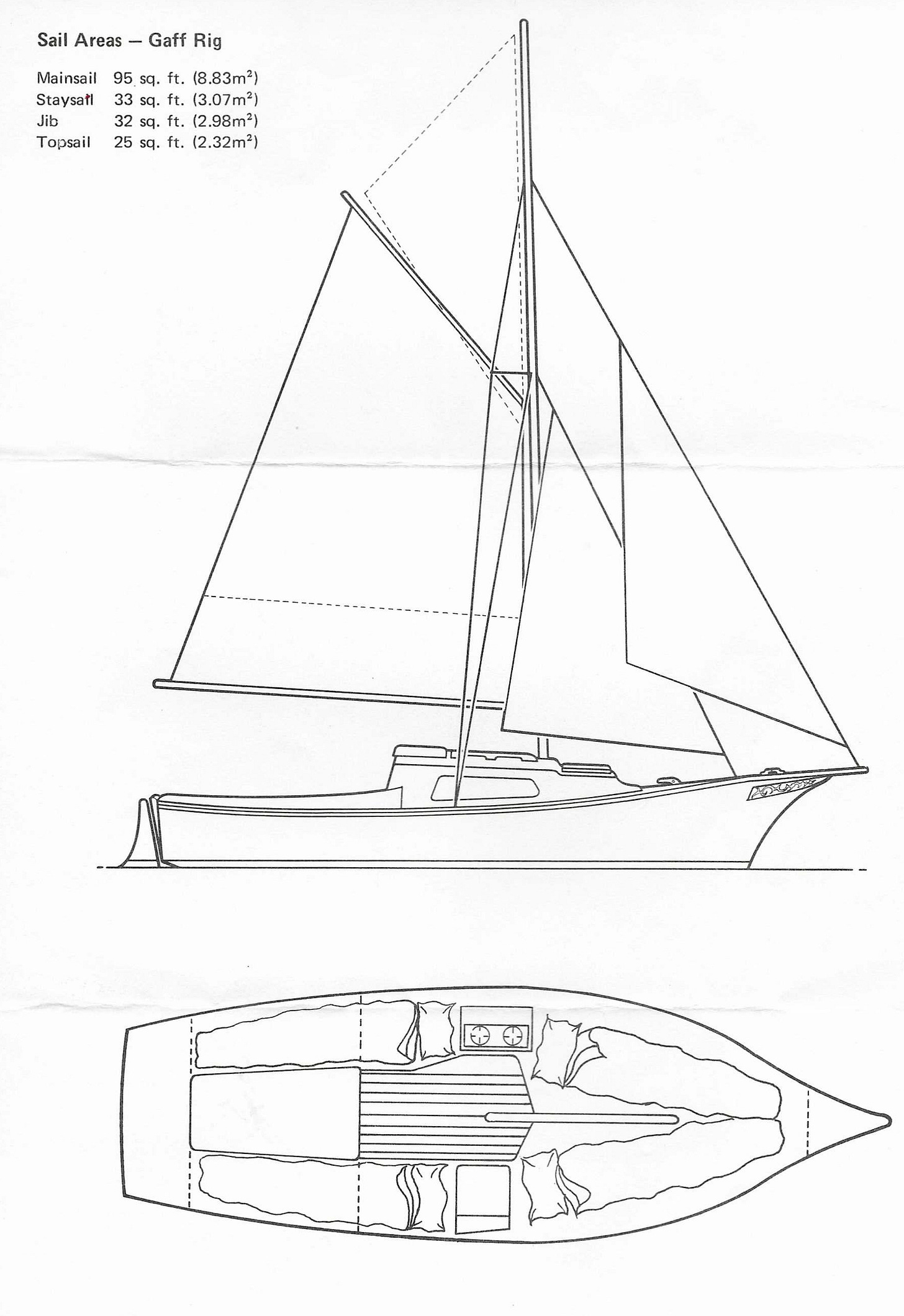

Love the clipper bow! Would be nice to see how she handles. Great article!
Made many overnights and multi-day trips in the upper Chesapeake region with my 19' O'Day Mariner. Camp cruising a small boat is great fun! I call my cabin a "pup tent" on a boat. Nothing beats staying dry on a stormy night. Endured a particularly bad storm in Johnson Bay off Chincoteague Bay. Much heavy thunder, awesome lightening display and high winds anchored in 4 feet of water. There with 2 other Mariners .. one of which dragged into the marshes! Quite a night.